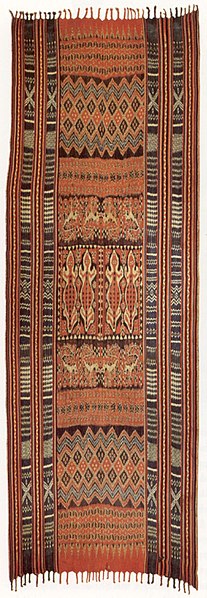Tenun is an artful Indonesian technique of making a fabric by weaving different colours of threads. Tenun belongs to one of the typical Indonesian cultural arts produced by hand skills using traditional looms. The word Tenun itself has a high meaning, historical value, and technique in terms of colors, motifs, and types of materials and threads used and each region has its own characteristics. In addition, Tenun is also one of Indonesia's original cultural heritages that is still maintained and preserved to this day.
A traditional weaver from Sumatra
The Tenun weavers in Yogyakarta, circa 1900
Tenun Baduy
Bentenan
Ikat is a dyeing technique from Indonesia used to pattern textiles that employs resist dyeing on the yarns prior to dyeing and weaving the fabric. The term is also used to refer to related and unrelated traditions in other cultures. In Southeast Asia, where it is the most widespread, ikat weaving traditions can be divided into two general clades. The first is found among Daic-speaking peoples. The second, larger group is found among the Austronesian peoples and spread via the Austronesian expansion. Similar dyeing and weaving techniques that developed independently are also present in other regions of the world, including India, Central Asia, Japan, Africa, and the Americas.
A typical Torajan ikat funeral shroud (porilonjong), Sulawesi, Indonesia
The Banton Burial Cloth (c. 1200-1400 AD), the oldest existing example of warp ikat in Southeast Asia at the National Museum of the Philippines). The cloth was found in the sacred Ipot cave of Romblon, Philippines. It is made from abacá, a species of endemic banana.
Detail of a classic Gujarati patola of double ikat from the early 19th century. LACMA textile collections.
A child wearing an ikat robe, Samarkand 19th century. Children often wore small versions of adult clothing.








